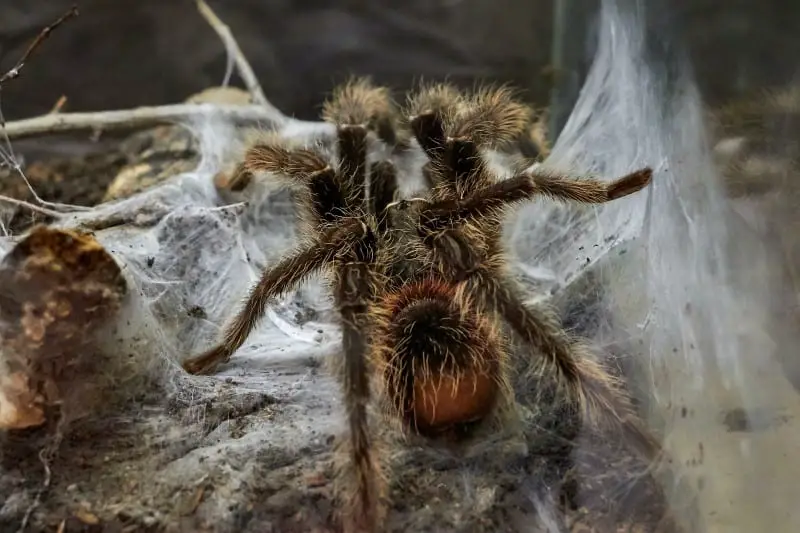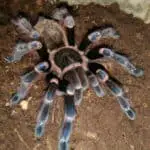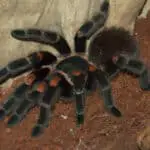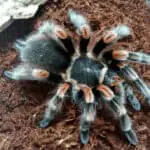Tarantulas are not the most active member of the animal kingdom. Often they will not move for days, which understandingly can be a cause for concern.
A motionless pet is always going to cause significant worry about whether the pet is actually okay. This is why tarantula owners will often have plenty of questions in regards to tarantulas and hibernation.
Do pet tarantulas hibernate? Tarantulas enter a hibernation-like state when temperatures get low. Pet tarantulas usually do not need to hibernate because they are not exposed to the cold temperatures during the colder months of the year. Conversely, if kept at temperatures below 65°F, some pet tarantulas may go into hibernation.
There are many different reasons why a tarantula may not be moving, and not all of its periods of inactivity are going to be the same. To find out more, continue reading below.

Can Tarantulas Hibernate?
Tarantulas can behave strangely sometimes, and they can spend a lot of time being motionless. But is that time spent motionless considered hibernation, or is there something more to it?
Tarantulas enter a state of inactivity that is very similar to hibernation, but it is not considered a true hibernation.
The Different Types of Inactivity
Despite their smaller stature, spiders (and tarantulas included) are complex creatures. This is why it is worth going through a few details about their behavior in order to understand them better.
When talking about tarantulas and spiders, you will often come across a few different terms being used, often interchangeably, which may not be used correctly.
- Hibernation refers to a period of reduced to a minimum metabolic and body activity. It can be predictive or consequential. During the hibernation, the living organism will usually maintain very low body temperature, minimal breathing, and a slow heart rate. Hibernation is usually seasonal and most often observed during the colder, winter months of the year. During the summer, animals that hibernate will usually eat more in order to accumulate more body fat.
- Diapause is a predictive period of inactivity when any growth and development of the organism is delayed as a result of unfavorable living and environmental conditions. Interestingly enough, diapause is usually predetermined in the animal’s genes.
- Torpor is a period of suppressed metabolic rates and physical inactivity. It can be daily or long term, and it may not be voluntary. It is often compared to hibernation; long-periods of torpor can even be considered a type of hibernation. Torpor may also be considered a form of diapause. However, torpor is characterized by the animal being capable of waking up for brief periods of time to feed or drink water before going back into torpor.
- Brumation is a period of inactivity by cold-blooded animals. During brumation, the animal will spend long periods of time inactive and may occasionally wake up to drink water before going back to being inactive.
- Aestivation is a period of dormancy reduced metabolic rates and activity during hot and dry weather conditions.
Hibernation, diapause, torpor, brumation, and aestivation, are all different types of dormancy, each of which is characterized by subtle differences and can be observed among different animal species.
Tarantulas (and other spiders) are cold-blooded, which means that they cannot really regulate their own body temperature. (If they could, tarantulas would not have such severe problems if kept in a very hot and humid tank, for example.)
Since hibernation, as per the above-mentioned statement, refers to animals that can regulate their body temperature, among other things, this means that spiders cannot really enter a true state of hibernation.
Tarantula’s periods of inactivity may be more close to diapause, torpor, or even brumation. However, there is no clear consensus as to what would be the correct terminology for tarantulas dormancy periods. This is why in reality, you may see each one of those terms being used almost interchangeably.
For the sake of clarity, I will refer to tarantula’s periods of inactivity as hibernation throughout the article when needed.
Wild-Caught vs. Captivity Bred Tarantulas
Normally when in captivity, tarantulas do not hibernate—especially if they have been bred in captivity. Wild-caught tarantulas, on the other hand, do tend to exhibit different behavior. Wild-caught tarantulas depending on the climate they live in and the time of the year may hibernate.
Tarantulas do not usually hibernate in captivity because they are taken away from their natural environment, and the associated cues that will tell the tarantula it should hibernate are not present.
Those cues are the shortening daytime and the steady lowering in the temperatures during the day and night.
Conversely, even captivity bred tarantulas can hibernate in certain cases. For example, if the room temperature gets too low, and there is also a lack of natural light.
New World vs. Old World Tarantulas
Tarantulas can be found in many different parts of the world. Interestingly enough, their habitat may also affect their behavior.
New world tarantulas may be more prepared and used to hibernating during the winter simply because they may usually experience more variations in the temperature where they live.
On the other hand, old world tarantulas live in predominantly warmer climates and thus have less experience with going into hibernation.
However, both the new world and old world tarantulas will become dormant and go into a hibernation-like state during particularly cold periods of time.
Read more about Old World vs New World Tarantulas, What’s the Difference?
What Do Tarantulas Do in the Winter?
Tarantulas will be actively monitoring their surroundings and ambient conditions for anything that may affect their well-being.
Some species of spiders will go into a state of hibernation, which is called cold-hardening. By hardening their body, those spiders can improve their survival odds during the cold temperatures in the winter.
But tarantulas are not like that.
As the temperatures drop, tarantulas will prepare for the winter. They will make a spot where they can hide safely and stay warmer. Eventually, after entering their burrows, tarantulas will seal the entrance with soil and debris.
In addition to that, their metabolism will gradually slow down. Colder temperatures usually signify less food availability, and by slowing down, their metabolism tarantulas will have higher chances of surviving the winter.
Tarantulas are not very active to begin with; however, if the ambient temperature drops very low, they tend to get even less active. If the room or outside temperature drops below 65°F, some tarantulas will become significantly less active but may also stop eating. In other words, during the winter, some tarantulas will hibernate.
Tarantulas’ hibernation behavior is not determined by the time of the year or the season but by the ambient temperatures. This means that it can also be summer, but if you keep the room particularly cold, your tarantula will go into a form of hibernation.
Tarantula Behavior That Can Be Mistaken With Hibernation
Just because a tarantula is not moving does not mean it is hibernating.
In order to provide the best care for a tarantula, it is important to discern between the different reasons why a tarantula will not be moving.
Let’s take a look.
Normal Behavior
Tarantulas are nocturnal creatures—which is another word to say that they are the most active during the night. They spend the day mostly in their shelters being inactive.
This behavior can sometimes be confused with a state of hibernation; however, the tarantula is active; it just prefers to stay away from the sunlight and heat.
Pre-molt
When a tarantula is in premolt, it becomes lethargic; it doesn’t move or eat. Tarantulas usually prepare for that period as it can last several months.
Tarantulas that are in premolt will usually display a very healthy plump abdomen and will prepare a molt bed, so to speak. Depending on their species, they can either dig a burrow in which they will hide or climb along some of the plants, logs, and wood barks in their tanks.
Molting
While molting, tarantulas will not move. This is a completely normal part of the process of molting, and you should not be worried about it.
One of the mistakes many owners make is to try and touch, mist, and otherwise tamper with it while it is molting. Molting is a very delicate process, and the tarantula should not be disturbed in any way as this can do more harm to it than good.
That being said, the molting process can usually last up to 48 hours depending on the species of tarantula, its health condition, the habitat, and other factors.
Old Age
Another reason why a tarantula may not be very active and lively is due to old age. As they grow older, they will try to conserve their energy and will appear less active as a result.
Sickness and Death
Possibly the most obvious reason why a pet tarantula may not be moving is that it is very stressed out or in bad health, and it is dying. In this case, tarantulas will not be moving at all. Eventually, the tarantula will start to slowly tighten and curl up its legs underneath its body, which is also known as the “death curl”.








